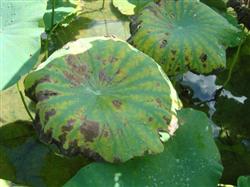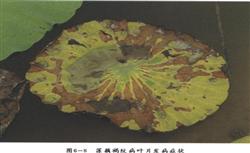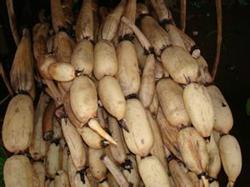Occurrence and control of brown class disease of lotus root

Brown class disease is the main disease of lotus root, which is widely distributed. It can occur in spring, summer and autumn. Generally, the diseased plant accounts for 30%-50%. In severe cases, the incidence rate can reach more than 80%, which significantly affects the yield and quality of lotus root. 1. Symptoms this disease mainly harms the leaves and petioles of lotus roots. The leaves have small brown-green spots at the beginning of the disease, and then expand into reddish brown to dark brown irregular to polygonal necrotic spots, with yellow halos on the periphery, the size of which is 2mm to 10mm, and the disease spots often have concentric lines, and in the later stage, the disease spots often merge with each other to form large patches, turn brown and dry. If the petiole is susceptible, it is easy to break and sag. When the air humidity is high, the surface of the disease spot will produce a gray-brown sparse mildew layer. two。 The pathogen overwintered with the diseased and residual tissue. When the temperature and humidity are suitable, conidia are produced and primary infection is formed. Conidia reinfection occurs after the onset of the disease. 3. ① agricultural control methods: combined with cutting stubble before winter, thoroughly clean up the diseased and residual old leaves, concentrate comminution and retting fertilizer, reduce the source of bacteria in the field, strengthen fertilizer and water management, increase the application of phosphorus, potassium and zinc fertilizer, timely and moderately drain the field, promote root growth, and enhance plant disease resistance. ② chemical control: at the initial stage of the disease, you can choose 50% dimethrin wettable powder 500x liquid or 40% Fuxing EC 5000 times liquid, or you can also use 70% methyl thiophanate wettable powder 600x liquid or 40% isoprazin wettable powder 600x liquid spray, spray once in 7 days and 15 days, 2 times in a row for 4 times.
- Prev

Identification and control of lotus root brown scab
Brown rot of lotus root is widely distributed and occurs everywhere, but it is only harmful to lotus root. 1. Pathogen: the disease is caused by the infection of Alternaria subphylum. The pathogen overwintered in the lotus root field with mycelium and thick spores, produced conidia at high temperature and humidity and spread by wind and rain. 2. Symptoms.
- Next

Cultivation techniques of lotus root in arch shed
1. Select improved varieties: select medium-ripe, 4-5-node main lotus root varieties. 2. Processing seed lotus root: Choose the main lotus root with strong lotus bud, 2-3 nodes and weight of more than 0.5 kg as seed lotus root, or select large seed lotus root as seed lotus root. After digging lotus roots, plant them as early as possible, and the seed amount per mu is 300-400 kg. Before planting...
Related
- Where is it suitable to grow horseradish in China? it is expected to see the middle altitude horseradish in Alishan.
- How to prevent tomato virus disease reasonably? (Control methods included)
- Many people like to plant towel gourd on the balcony. What are the main points of this method and management?
- What crops can chili peppers be mixed with?
- Fertilization techniques and matters needing attention in Tomato
- What are the grafting techniques for peach seedlings in spring?
- Harm and control methods of root swelling disease of Chinese cabbage
- What are the pests of sweet potatoes? How to prevent and cure it?
- Symptoms, causes and Control methods of navel Rot in Tomato
- The cause of "Cucumber rotten bibcock" in Farmers' planting Cucumber and its Control Plan

